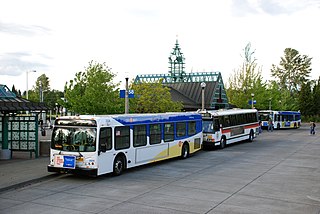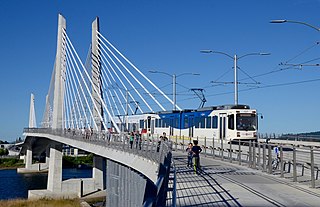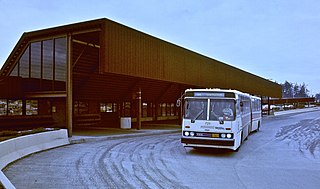
Oregon City is the county seat of Clackamas County, Oregon, United States, located on the Willamette River near the southern limits of the Portland metropolitan area. As of the 2020 census, the city population was 37,572. Established in 1829 by the Hudson's Bay Company, in 1844 it became the first U.S. city west of the Rocky Mountains to be incorporated.

Canby is a city in Clackamas County, Oregon, United States. The population was 18,171 at the 2020 census. It is along Oregon Route 99E, 2 miles (3 km) northeast of Barlow.

Wilsonville is a city primarily in Clackamas County, Oregon, United States. A portion of the northern section of the city is in Washington County. It was founded as Boones Landing because of the Boones Ferry which crossed the Willamette River at the location; the community became Wilsonville in 1880. The city was incorporated in 1969 with a population of approximately 1,000. The population was 13,991 at the 2000 census, and grew to 19,509 as of 2010. Slightly more than 90% of residents at the 2000 census were white, with Hispanics comprising the largest minority group.

The Tri-County Metropolitan Transportation District of Oregon (TriMet) is a transit agency that serves most of the Oregon part of the Portland metropolitan area. Created in 1969 by the Oregon legislature, the district replaced five private bus companies that operated in the three counties: Multnomah, Washington, and Clackamas. TriMet began operating a light rail system, MAX, in 1986, which has since been expanded to five lines that now cover 59.7 miles (96.1 km). It also operates the WES Commuter Rail line since 2009. It also provides the operators and maintenance personnel for the city of Portland-owned Portland Streetcar system. In 2023, the system had a ridership of 62,055,600, or about 206,400 per weekday as of the third quarter of 2024.

Sandy Area Metro is a public transit system operated by the city government of Sandy, Oregon. SAM was created after the city successfully petitioned to be removed from the TriMet district in the late 1990s. The name was chosen in July 1999, and service began operating on January 4, 2000. The local transit provider gave its one-millionth ride on November 21, 2006 and began its twentieth year in January 2019. SAM maintains three routes, a dial-a-ride service called Sandy Transit Area Rides (STAR), and an Elderly and Disabled (ED) medical rides program.

The MAX Blue Line is a light rail line serving the Portland metropolitan area in the U.S. state of Oregon. Operated by TriMet as part of the MAX Light Rail system, it connects Hillsboro, Beaverton, Portland, and Gresham. The Blue Line is the longest in the network; it travels approximately 33 miles (53 km) and serves 48 stations from Hatfield Government Center to Cleveland Avenue. It is the busiest of the five MAX lines, having carried an average 55,370 riders each day on weekdays in September 2018. Service runs for 221⁄2 hours per day from Monday to Thursday, with headways of between 30 minutes off-peak and five minutes during rush hour. It runs later in the evening on Fridays and Saturdays and ends earlier on Sundays.

The MAX Yellow Line is a light rail line serving Portland, Oregon, United States. Operated by TriMet as part of the MAX Light Rail system, it connects North Portland, Portland City Center, and Portland State University (PSU). The line serves 17 stations; it runs north–south from Expo Center station to PSU South/Southwest 6th and College station, interlining with the Green and Orange lines within the Portland Transit Mall. Service runs for 21 hours per day with headways of up to 15 minutes. The Yellow Line is the fourth-busiest service in the MAX system; it carried an average 12,960 riders per weekday in September 2019.

Beaverton Transit Center is a multimodal transport hub in Beaverton, Oregon, United States. Owned and operated by TriMet, it is served by bus, commuter rail, and light rail. The transit center is MAX Light Rail's 15th station eastbound on the Blue Line and 11th station eastbound on the Red Line. It is also the northern terminus of WES Commuter Rail and a hub for bus routes mostly serving the westside communities of the Portland metropolitan area. Beaverton Transit Center is situated on Southwest Lombard Avenue, just north of Southwest Canyon Road in central Beaverton, connected by walkway to Canyon Place Shopping Center. It recorded 9,709 average weekday boardings for all modes in fall 2018, making it TriMet's busiest transit center.

South Metro Area Regional Transit (SMART) is a public transit system operated by the city government of Wilsonville, Oregon, United States. The system currently consists of seven routes and is funded by local businesses. It was created when Wilsonville petitioned to withdraw from the TriMet service district in the late 1980s.
The South Clackamas Transportation District (SCTD) is a bus service that provides public transportation in Molalla, Oregon, connecting that city to Clackamas Community College in Oregon City, and Canby. The cost to ride to or from CCC is only US$1; rides to or from Canby used to be free, but now also cost US$1.

The MAX Green Line is a light rail line serving the Portland metropolitan area in the U.S. state of Oregon. Operated by TriMet as part of the MAX Light Rail system, it connects Portland State University (PSU), Portland City Center, Northeast Portland, Southeast Portland, and Clackamas. The Green Line is 15 miles (24.1 km) long and serves 30 stations from the PSU South stations to Clackamas Town Center Transit Center. It is the only service that interlines with all of the other MAX services, sharing the Portland Transit Mall segment with the Orange and Yellow lines and part of the Eastside MAX segment with the Blue and Red lines. South of Gateway Transit Center, the Green Line branches off to Clackamas Town Center. Service runs for 21 hours on weekdays and 20 hours on weekends with headways of up to 15 minutes. It is the third-busiest line in the system with an average of 19,160 riders per day on weekdays in September 2019.

The MAX Orange Line is a light rail line serving the Portland metropolitan area in the U.S. state of Oregon. Operated by TriMet as part of the MAX Light Rail system, it connects Portland City Center, Portland State University (PSU), Southeast Portland, Milwaukie, and Oak Grove. The line serves 17 stations and runs for 201⁄2 hours per day with headways of up to 15 minutes. It averaged 3,480 daily weekday riders in September 2020.

The Westside Express Service (WES) is a commuter rail line in the U.S. state of Oregon serving parts of Washington and Clackamas counties in the Portland metropolitan area. Owned by TriMet and operated by Portland & Western Railroad (P&W), the line is 14.7 miles (23.7 km) long and travels north–south from Beaverton to Wilsonville along a route just west of Oregon Highway 217 and Interstate 5 (I-5). WES consists of five stations and connects with MAX Light Rail at Beaverton Transit Center. Service operates on a 45-minute headway on weekdays during the morning and evening rush hours. In Spring 2022, WES saw a daily ridership of 420 passengers or about 109,000 riders annually.

The Clackamas Town Center Transit Center is a bus transit center and MAX Light Rail station, located in Clackamas County, Oregon, in the southeastern part of the Portland metropolitan area. Clackamas Town Center TC is the southern terminus of the MAX Green Line, which began service in 2009.

Wilsonville Transit Center, also called SMART Central at Wilsonville Station, is a bus and commuter rail transport hub in Wilsonville, Oregon, United States. The transit center, which is owned and operated by the City of Wilsonville, is the hub for the South Metro Area Regional Transit (SMART) bus system. The Portland metropolitan area's regional transit agency, TriMet, operates the southern terminus of its WES Commuter Rail at the facility; WES connects with the Blue and Red lines of MAX Light Rail at Beaverton Transit Center. Opened in January 2009, the transit center includes a 400-car park and ride.

Tigard Transit Center, formally Thomas M. Brian Tigard Transit Center, is a transport hub in Tigard, Oregon, United States, that is owned and operated by TriMet. It is a transfer facility for bus routes mainly serving the westside communities of the Portland metropolitan area and the third southbound station from Beaverton Transit Center on WES Commuter Rail. The transit center is the located in downtown Tigard just south of Oregon Route 99W on Commercial Street. It recorded 1,627 average weekday boardings in fall 2019. The facility opened in 1988 as a bus transit center, and a platform for WES was added in 2009.

Tualatin is a train station in Tualatin, Oregon, United States, served by TriMet as part of WES Commuter Rail. Situated next to Hedges Green Shopping Center on Southwest Boones Ferry Road, it is the fourth station southbound on the commuter rail line, which operates between Beaverton and Wilsonville in the Portland metropolitan area's Washington County. The station includes a 129-space park and ride and connections to the Tualatin Shuttle and TriMet bus routes 76–Hall/Greenburg and 97–Tualatin–Sherwood Rd. WES connects with the Blue and Red lines of MAX Light Rail at Beaverton Transit Center.

Hall/Nimbus is a train station in Beaverton, Oregon, United States, served by TriMet as part of WES Commuter Rail. It is the second station southbound on the commuter rail line, which runs between Beaverton and Wilsonville in the Portland metropolitan area's Washington County. Opened in February 2009, the TriMet-owned station is located west of Oregon Route 217 near the Washington Square shopping mall on Hall Boulevard. It includes a 50-car park and ride and connections to TriMet bus routes 76–Hall/Greenburg and 78–Beaverton/Lake Oswego. WES connects with the Blue and Red lines of MAX Light Rail at Beaverton Transit Center.

The Barbur Boulevard Transit Center is a TriMet transit center located at 9750 SW Barbur Boulevard, near the intersection with Capitol Highway in southwest Portland, Oregon. Barbur TC is proposed to be a future stop on the MAX Green Line as part of the SW Corridor MAX Project, which would extend the Green Line from its current terminus at the PSU South stations southward to Bridgeport Village in Tualatin.




















